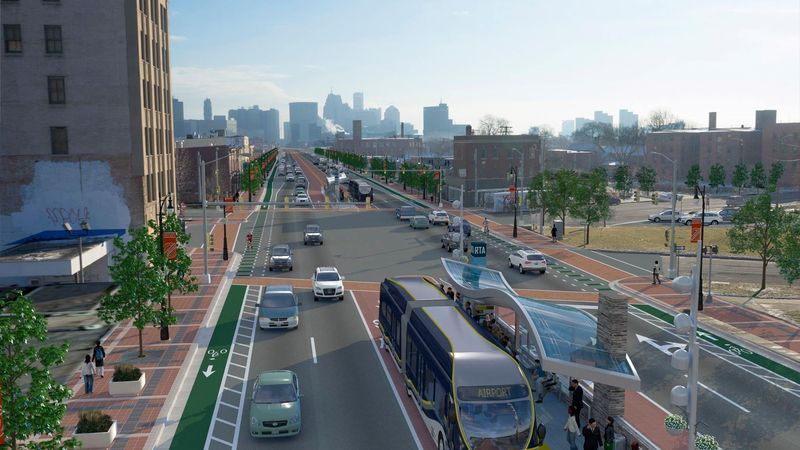With the vote on the Detroit area regional transit tax just about six weeks away, the agency that would oversee the expanded transportation services says that it will “fill in the gaps” left by the SMART suburban bus system.
A Regional Transit Authority (RTA) official told a Macomb County business group today that the millage on the Nov. 8 ballot would broaden southeast Michigan’s public transportation to serve all commuters, not just low-income workers who don’t have a car or access to other transit.
“About 92 percent of people in the region can’t get to work in under one hour using public transportation,” said Tiffany Gunter, deputy CEO of the RTA.
The 1.2-mill tax on the ballot would spark an ambitious plan that centers around the introduction of rapid transit buses on the three main tri-county arteries: Gratiot, Woodward and Michigan avenues. Bus Rapid Transit, or BRT, consists of transit vehicles that are more like a small train on tires than a bus. (The concept drawing above shows a BRT vehicle on Michigan Avenue near downtown Detroit.)
These BRT buses would travel in a road lane dedicated solely to their use and would benefit from technology that allows them mostly to avoid stop lights at cross streets. As a result, they could traverse those three main thoroughfares quicker than a typical bus provided by SMART, the Suburban Mobility Authority for Regional Transportation.
At the same time, the agency would rely upon SMART and the Detroit Department of Transportation (DDOT) buses to provide east/west cross connections to the rapid transit bus lines. The BRT buses would stop every 10 minutes – at newly built transit stations – during rush hour and every 20-25 minutes during off-peak hours.
Other improvements, Gunter said, would include the creation of a regional commuter fare card with a magnetic strip on the back to quickly handle billing and allow transfers from one bus to another, without coins or dollars involved. That is an improvement, she said, that should have been made decades ago.
Speaking to the Gratiot Avenue Chamber of Commerce, Guntert said the RTA plan also calls for BRT service from the city and suburbs to Detroit Metropolitan Airport, plus a commuter train from Ann Arbor to Detroit’s inner city. Some additional bus service of the traditional kind is also in the works.
Formed in 2012, the RTA is a coordinating agency governed by a 10-member board with representatives from Wayne, Oakland, Macomb and Washtenaw counties, plus members appointed by Detroit and Gov. Rick Snyder.
The RTA’s first real foray into public transit came earlier this month as a new “Reflex” bus service on Gratiot and Woodward offered expanded ride times from 5 a.m. to 1 a.m. on weekdays. Those new green buses are driven and maintained by SMART and DDOT drivers and mechanics.
That latest transportation offering, made possible due to federal grants, was initially planned three years ago. The debut was not timed to occur just before the election, officials say. “It shows that the RTA can make a difference,” Gunter said, such as traveling from inner city Detroit to the Macomb Mall in Roseville in 35 minutes.
The sales pitch for the RTA plan goes something like this:
- The proposed 20-year, 1.2-mill property tax would cost the average homeowner with a house valued at $160,000 about $96 a year, or $8 a month.
- The funding would gradually adhere to a policy that 85 percent of the tax revenue would be spent for services in the county where those millage dollars were raised.
- The local dollars generated will lead to federal and state transit funds, a contribution that will exceed $1 billion for the RTA from 2017-2036.
- Similar BRT systems in Cleveland, Kansas City, Las Vegas and Pittsburgh have generated billions of dollars in economic development over time along the rapid-bus routes.
- While the current SMART/DDOT bus service, focused on the elderly, disabled and low-income, spends about $69 per capita in the region, the RTA plan would provide services to average commuters by increasing per capita spending to $157, which is in line with many major metropolitan areas across the nation.
After speaking to the Gratiot chamber at the Avante banquet hall in Clinton Township, Gunter said the RTA plan, if proposed from scratch, would probably have required 4 to 5 mills of taxes. But she said the modest 1.2-mill ballot proposal, by leveraging existing bus services and regional coordination, plus a fiscally conservative approach to future cost estimates, will keep the tax rate reasonable and realistic.
The RTA system is based on a “cash model” with just 1.3 percent of the budget relying upon debt. A more robust public transit system will have to wait, Gunter said.
“Right now, the (public) appetite isn’t quite what we would like it to be,” she explained. “We have to build to that.”









Prediction: The millage proposal will fail.
SMART bus system didn’t do my elderly mom a bit of good going from NorthWest Warren to Troy Beaumont (19&Dequindre) . Botched pickups, missed appointments. I gave up on it. Ended up driving my mom myself, to every appointment for doctors, physical therapy, checkups, etc. I ended up filing formal complaint, never used SMART again.
Vote NO.
Well Chadly, I’m sure since you are retired that you would be the 1st in line to vote YES on this tax increase with your limited amount of income from your pension. I’m sure everyone that lives on a fixed income would gladly endorse this. This is your wet dream right? More tax payer funded transit to help us working people get to work all the while the unemployed sit at home and pay nothing. No thanks Chad-O. This should be a definite DOA. How’s your buddy Bruley doing these days? Still fuming over Hackel? Ha Ha!!
NO! Northern Oakland County residents and businesses will derive to benefits whatsoever from the RTA. NO, NO and NO!